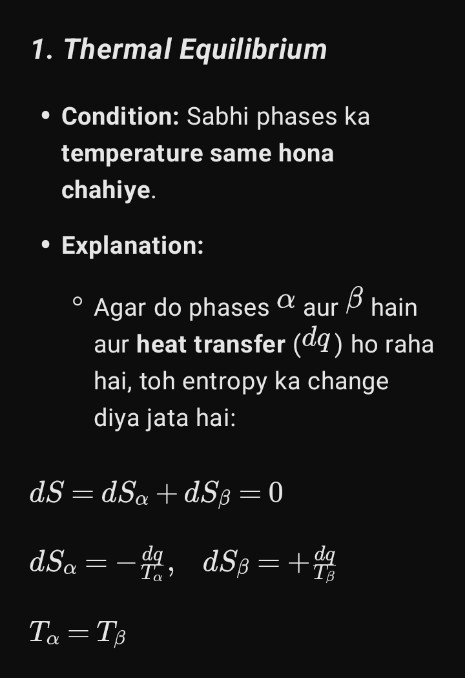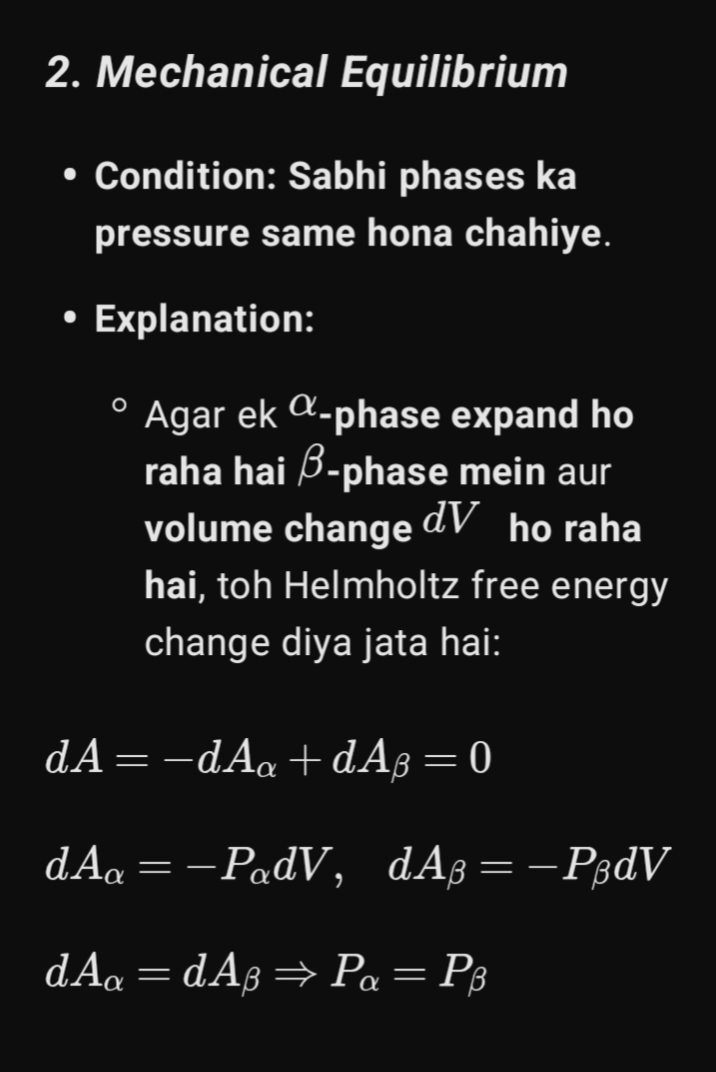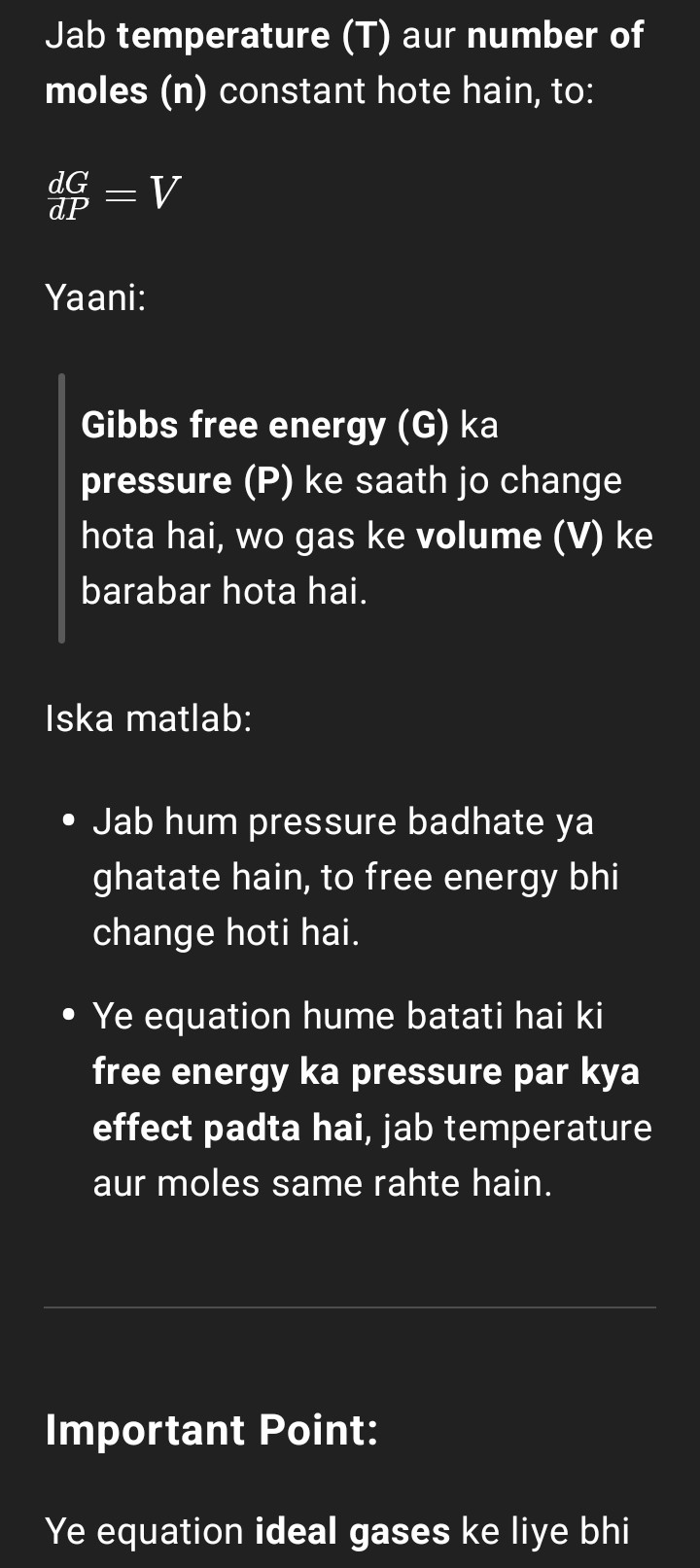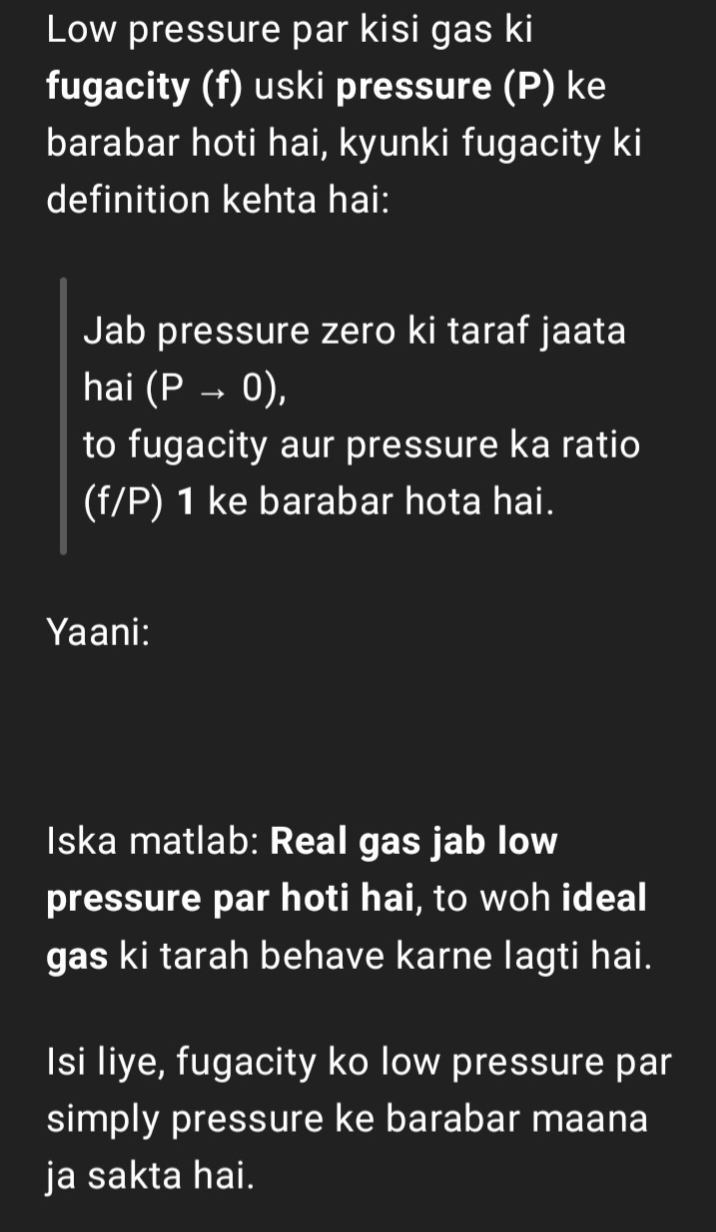Phase Equilibrium
1/27
There's no tags or description
Looks like no tags are added yet.
Name | Mastery | Learn | Test | Matching | Spaced |
|---|
No study sessions yet.
28 Terms
Phase
Phase ek homogeneous aur physically distinct part hota hai kisi system ka, jo ek surface se bound hota hai aur mechanical tareeke se doosre parts se alag kiya ja sakta hai.
Examples:
Gas mixture: Ek single phase hota hai kyunki gases ek doosre ke saath completely mix ho jaati hain.
Immiscible liquids: Alag-alag phases banate hain, jaise carbon tetrachloride aur water jo mix nahi hote, isliye yeh do phases banate hain.
Completely miscible liquids: Jaise water aur alcohol, ya benzene aur chloroform, yeh ek phase system banate hain kyunki yeh ek doosre mein completely mix ho jaate hain.
Calcium carbonate ka decomposition: Jab CaCO₃ decompose hota hai CaO aur CO₂ mein, toh yahaan do solid phases (CaCO₃ aur CaO) aur ek gaseous phase (CO₂) hota hai. Isliye yeh ek three-phase system hota hai.
Homogeneous ka matalab
Homogeneous ka matlab hota hai "ek jaisa" ya "poori tarah se ek samaan". Jab koi substance ya mixture har jagah ek jaisa dikhta hai aur uski composition same hoti hai, tab use homogeneous kaha jata hai.
Examples:
1. Salt water (Namak wala pani) – Pani mein namak achhe se ghul jata hai, isliye yeh ek homogeneous mixture hai.
2. Air (Hawa) – Hawa mein different gases (oxygen, nitrogen, carbon dioxide) ek jaisi mili hoti hain, isliye yeh bhi homogeneous mixture hai.
3. Sugar solution (Cheeni ka ghol) – Pani mein cheeni achhe se ghul jaye, toh yeh bhi homogeneous hota hai.
Agar koi mixture alag-alag parts mein divide ho jaye ya usme alag layers dikhai de, toh use heterogeneous kehte hain.
Components
Equilibrium par kisi system ke components ki number ka matlab hota hai sabse kam number un independent constituents ka, jinse har phase ki composition ko express kiya ja sake, ya toh seedhe ya phir kisi equation ke madhyam se.
Simplified Explanation:
Component woh cheez hoti hai jo system ki composition ko define karti hai.
Equilibrium par, humein minimum number of independent constituents chahiye, jisse har phase ki composition likhi ja sake.
Yeh directly likhi ja sakti hai ya kisi equation ke zariye bhi express ho sakti hai.
Example:
1. Water (H₂O) aur Steam (H₂O vapour) – Yahaan sirf ek component hai (H₂O), kyunki pani aur uski bhaap dono ka composition same hai.
2. CaCO₃ ⇌ CaO + CO₂ – Yahaan teen phases hain (CaCO₃ solid, CaO solid, aur CO₂ gas), lekin sirf do independent components hain (CaO aur CO₂), kyunki CaCO₃ ko in dono ki madad se likha ja sakta hai.
Matlab, jitne kam independent constituents use karke system ka composition likha ja sake, wahi uske components hote hain.
Independent constituents
Independent constituents ka matlab hai aise elements ya compounds jo system ki composition ko define karne ke liye zaroori hote hain aur jo ek doosre se directly derive nahi ho sakte.
Simplified Explanation:
Independent constituents woh hote hain jo system ke har phase ki composition ko express karne ke liye directly chahiye hote hain.
Agar ek substance doosre se equation ke madhyam se likha ja sakta hai, toh woh independent nahi hota.
Example:
1. Water (H₂O) aur steam (H₂O vapour)
Yahan sirf ek independent constituent hai – H₂O, kyunki pani aur bhaap dono ka composition same hai.
2. CaCO₃ ⇌ CaO + CO₂ (Calcium carbonate ka decomposition)
Is system me do independent constituents hain – CaO aur CO₂, kyunki CaCO₃ in dono se derive ho sakta hai (CaCO₃ = CaO + CO₂).
Matlab, jo constituents ek doosre se directly derive nahi kiye ja sakte, wahi independent hote hain.
C=N-E
Chemical reactive system mein components (C) ki sankhya nikalne ka formula hai:
C = N - E
Yahaan:
N = Chemical species ki total sankhya (jitne alag-alag chemical substances system mein hain).
E = Independent chemical equations ki sankhya (jitni equations un species ke beech relation establish karti hain).
Samajhne ke liye points:
1. Chemical Reaction Ka Role:
Agar koi chemical reaction ho raha hai, toh system mein total chemical species (N) ho sakti hain, par unka relationship independent equations (E) se define kiya jata hai.
2. Independent Equations Ka Impact:
Jitni independent equations (E) hoti hain, utni species ki dependency badh jati hai, isliye components (C) ka number kam ho jata hai.
3. Ions Aur Electrical Neutrality:
Agar ions involved hain, toh electrical neutrality bhi ek independent equation hoti hai.
Example of components
Example 1:
Reaction:
CaCO₃ ⇌ CaO + CO₂
N = 3 (CaCO₃, CaO, CO₂)
E = 1 (ek independent reaction equation hai)
Components (C):
C = N - E = 3 - 1 = 2
(Independent components: C
aO aur CO₂).
Components concept
Concept Ko Samajhne Ke Liye:
1. Reaction Ke Bina:
Agar system mein koi reaction nahi ho rahi hai, toh saare species independent hote hain.
Example: Agar N = 3 (A, B, C) aur E = 0 (koi reaction nahi), toh C = 3 - 0 = 3.
2. Reaction Ke Saath:
Agar reaction ho rahi hai, toh kuch species ke concentration dusre species ki wajah se determine ho jate hain.
Example: Agar N = 3 (A, B, C) aur E = 1 (A + B ⇌ C), toh C = 3 - 1 = 2.
3. Electrical Neutrality:
Agar ions involved hain, toh electrical neutrality bhi ek independent equation hoti hai.
Example: Agar N = 4 (Na⁺, Cl⁻, H₂O, NaCl) aur E = 1 (NaCl ⇌ Na⁺ + Cl⁻), aur electrical neutrality bhi consider karenge, toh E = 2.
Isliye,
C = 4 - 2 = 2.
Final Takeaway:
N = Total species.
E = Independent equations (reactions + electrical neutrality, if applicable).
C = N - E = Truly independent components.
Chemical reactive system mein components (C) ka number nikalne ke liye hum C = N - E formula use karte hain. Isme N total chemical species ki sankhya hoti hai, aur E independent chemical equations ki sankhya hoti hai. Par hum N mein se E ko minus kyu karte hain? Iska reason samajhna bahut important hai.
Reason 1: Independent Equations Species Ko Dependent Banati Hain
Independent Equations (E):
Ye equations chemical species ke beech ka relationship batati hain.
Example: Agar ek reaction hai A + B ⇌ C, toh ye equation batati hai ki C ka concentration A aur B ke concentration se related hai.
Impact:
Jab ek independent equation hoti hai, toh ek species (jaise C) ka concentration doosre species (A aur B) ke concentration se determine ho jata hai. Iska matlab hai ki C ab independent nahi raha, balki dependent ho gaya hai.
Minus Ka Logic:
Har independent equation ek species ko dependent bana deti hai. Isliye, total species (N) mein se independent equations (E) ko minus karke hum truly independent components (C) ka number nikalte hain.
Reason 2: System Ko Simplify Karne Ke Liye
Chemical system mein bahut saari species ho sakti hain, lekin kuch species apne aap mein independent nahi hote. Unka concentration doosre species ke concentration se determine hota hai.
Minus karke hum system ko simplify kar dete hain aur sirf truly independent components ko consider karte hain. Yeh hume system ki complexity ko kam karne mein help karta hai
Example:
System:4 chemical species: Na⁺, Cl⁻, H₂O, aur NaCl.
1. NaCl ⇌ Na⁺ + Cl⁻
2. Electrical neutrality: Na⁺ = Cl⁻
N = 4 (Na⁺, Cl⁻, H₂O, NaCl)
E = 2 (1 reaction + 1 electrical neutrality condition)
Components (C):
C = N - E = 4 - 2 = 2
Kyu?
Reaction equation (NaCl ⇌ Na⁺ + Cl⁻) ke wajah se, NaCl ka concentration Na⁺ aur Cl⁻ ke concentration se determine ho jata hai.
Electrical neutrality condition (Na⁺ = Cl⁻) ke wajah se, Na⁺ aur Cl⁻ ka concentration ek dusre se related ho jata hai.
Isliye, truly independent components sirf H₂O aur NaCl hain.
Isliye humne E = 2 ko N = 4 mein se minus kiya, taaki C = 2 (independent components) mile.
Degree of Freedom (F)
Degree of freedom (F) ka matlab hota hai wo number of independent variables (temperature, pressure, composition) jo system ko completely define karne ke liye specify karne padenge.
Example of F
Example 1: Ek Pure Gas (Single Phase)
Agar hum ek pure gas lete hain, to system ko define karne ke liye temperature (T) aur pressure (P) ya phir pressure (P) aur volume(V) specify karne padenge.
Isliye degree of freedom, F = 2 hota hai.
Conclusion: A pure gas ke paas 2 degrees of freedom hote hain.
Example 2: Water (Liquid) + Vapour (Two Phases)
Agar hum water-liquid aur vapour equilibrium consider karein, to P = 2 ho jayega.
C = 1 (kyunki sirf water hai).
F = 1 - 2 + 2 = 1
Matlab hume sirf ek variable specify karna padega (ya toh temperature ya pressure), dusra automatically fix ho jayega.
Conclusion: Yeh system monovariant (F = 1) hota hai.
Example 3: Ice + Water + Vapour (Three Phases)
Jab ice, liquid water aur vapour equilibrium mein hote hain, tab P = 3 ho jayega.
C = 1 (kyunki sirf water hai).
F = 1 - 3 + 2 = 0
Matlab koi bhi independent variable specify karne ki zaroorat nahi, kyunki yeh equilibrium ek fixed temperature aur pressure pe hoga.
Conclusion: Yeh system invariant (F = 0) hota hai.
Final Conclusion:
1. Zyada components (C) hone se degree of freedom (F) badhta hai.
2. Zyada phases (P) hone se degree of freedom (F) kam hota hai.
3.Agr kisi system mai components fixed hai, toh maximum possible phases tabhi exist kar skte hai jab degrees of freedom zero ho jayein.
Agar kisi bhi system ka F = 0 hai, toh uska equilibrium ek fixed temperature aur pressure pe hi possible hoga.
Thermal Equilibrium

Mechanical equilibrium

Gibbs phase rule
Gibbs Phase Rule yeh kehta hai ki agar ek heterogeneous system equilibrium par ho aur uspe gravity, electrical, ya magnetic forces ka koi asar na ho, toh us system ke degrees of freedom (F) ka relation number of components (C) aur number of phases (P) ke sath ek specific equation se diya jata hai:
F = C - P + 2
Iska matlab:
Degrees of Freedom (F): Yeh batata hai ki hum system ke kitne independent variables (jaise temperature, pressure, composition) ko bina equilibrium tod ke change kar sakte hain.
Components (C): Yeh woh chemical substances hain jo system mein mil kar phases banate hain.
Phases (P): System mein jitne alag-alag homogeneous parts hote hain (jaise solid, liquid, gas), unka count.
Yeh rule humein batata hai ki kisi bhi system mein kitni flexibility hai equilibrium maintain
karte waqt.
Example 3 (b) Liquid water aur water vapour in equilibrium at 1 atm pressure (fixed pressure)
F=C-P+1
F=0
Matlab: Ab koi degree of freedom nahi hai. System invariant hai. 1 atm par water ka boiling point (100°C) automatically set ho jata hai.
Invariant ka matalab
"Invariant" ka matlab hai ki system mein koi bhi degree of freedom nahi hai, yaani system ki properties (jaise temperature, pressure, composition) ko change nahi kiya ja sakta without breaking the equilibrium.
Example 3(b) mein:
System hai liquid water aur water vapour in equilibrium at 1 atm pressure.
Pressure fixed hai (1 atm), aur Gibbs Phase Rule ke hisab se F=0 hai.
Iska matlab hai ki temperature bhi fixed hai (100°C at 1 atm).
Agar aap temperature ya pressure ko change karne ki koshish karenge, toh system equilibrium mein nahi rahega.
Simple bhasha mein:
Invariant system mein sab kuch fixed hota hai, kuch bhi change nahi kar sakte.
Is case mein, 1 atm par water ka boiling point 100°C hai, aur yeh automatically set ho jata hai. Aap ise change nahi kar sakte.
Isliye, invariant system ko "fully determined" ya "fixed" system bhi kehte hain.
Eutectic point
Eutectic point ek aisa unique temperature hota hai jisme solid Lead (Pb), solid Silver (Ag), aur unka liquid solution ek saath equilibrium me hote hain. Matlab is point par teeno phases simultaneously exist karte hain.
✔ Eutectic point ek invariant point hota hai, matlab iska temperature aur composition fixed hota hai.
✔ Eutectic point ka temperature 303°C hota hai, aur solution phase ka composition 2.6% Silver hota hai.
✔ Is temperature se neeche koi bhi liquid exist nahi karega, sirf solid Lead + solid Silver ka mixture rehega.
Phase diagram for Ag-Pb
Page 1: Phase Diagram aur Eutectic Point Explanation
Is phase diagram me pressure ka koi significant effect nahi hota kyunki liquid aur solid par pressure ka negligible effect hota hai.
Is wajah se degrees of freedom reduce hoti hai, jo phase rule ke according hai:
F = C - P + 1
Eutectic point (O) par:
F = 2 - 3 + 1 = 0
Matlab F = 0, iska matlab hai ki temperature aur composition fixed hote hain (invariant system).
1. Curve AO represent karta hai freezing point curve for Silver (Ag).
2. Pure Silver ka melting point 961°C hota hai.
3. Jab Pb (Lead) add karte hain, toh Silver ka melting point gradually decrease hota hai.
4. Melting point minimum pahunchta hai at Point O (Eutectic Point).
5. Point O ka matlab hai ki ye sabse lowest temperature hoga jisme Silver aur Lead ek saath solidify ho jayenge.
Page 2: Eutectic Composition aur Melting Point Behavior
Eutectic composition of Silver (Ag) aur Lead (Pb):
2.6% Ag aur 97.6% Pb
Eutectic point (O) wo temperature hai jisme liquid directly Silver aur Lead ke mixture me solidify ho jata hai, bina kisi intermediate phase ke.
Curve AO ke along: Jab hum Pb add karte hain, toh wo Ag solution me dissolve hota hai, jisse melting point decrease hota hai.
Jab eutectic point (O) par pahunchte hain: Solution saturated ho jata hai, matlab ab aur Pb dissolve nahi hoga.
Eutectic point ke baad: Aur Pb add karne se Silver ka melting point aur decrease nahi karega.
Iska matlab Eutectic Point wo minimum temperature hai jisme system last time liquid phase me reh sakta hai, uske baad direct solid ho jata hai.
Phase diagram of Ag-Pb along curve BO
1. Curve BO represent karta hai freezing point curve for Lead(Pb).
2.Pure lead ka melting point 327°C hota hai.
3. Jab Ag(silver)add karte hain, toh lead(Pb) ka melting point gradually decrease hota hai and reaches a minimum at point O.
4.Curve BO ke along: Jab hum Ag add karte hain, toh wo Pb solution me dissolve hota hai, jisse melting point decrease hota hai.
Jab eutectic point (O) par pahunchte hain: Solution saturated ho jata hai, matlab ab aur Ag dissolve nahi hoga.
Eutectic point ke baad: Aur Ag add karne se lead (Pb) ka melting point aur decrease nahi karega.
Along the curve BO two phases coexist together, solid lead and liquid (melt) and therefore the system is univariant i.e.f=1.
Two curve BO and AO meet
"The most important partial molar property in physical chemistry is the partial molar free energy, designated as chemical potential, and represented as (∂G/∂nᵢ)ₜ,ₚ,ₙ = Ḡᵢ = μᵢ"
Physical chemistry mein sabse important partial molar property hoti hai:
> Partial molar free energy — jise chemical potential (μᵢ) kehte hain.
Iska matlab:
Jab temperature (T), pressure (P), aur baaki sabhi components ki quantity constant rakhi jaayein, to agar hum system mein ek mole kisi ek substance ka aur daalte hain, to Gibbs free energy (G) mein kitna change aata hai — wahi hota hai us substance ka chemical potential (μᵢ).
Mathematical form mein:
\mu_i = \left(\frac{\partial G}{\partial n_i}\right)_{T,P,n}
Yeh formula kehta hai:
Gibbs free energy ka partial derivative lo with respect to number of moles of component i (nᵢ), jab T, P, aur baaki components ke moles constant ho.
Jo value aayegi, wahi chemical potential μᵢ ya Ḡᵢ hai.
Asan Bhasha Mein:
Socho tumhare paas ek soup hai (mixture), usmein agar tum thoda sa namak daalte ho (1 mole), to taste (ya energy) mein jo badlav aata hai — wahi namak ka chemical potential hai.
Zyada change = zyada chemical potential
Kam change = kam chemical potential
The chemical potential of a given substance is evidently the change in free energy of the system that results from the addition of one mole of that particular substance at a constant temperature and pressure to such a large quantity of the system that there is no appreciable change in the overall composition of the system.
Chemical potential ka matlab hai:
> Jab hum ek mole kisi particular substance ka kisi system mein daalte hain — temperature aur pressure ko constant rakhte hue — to system ki free energy mein jo change aata hai, wahi us substance ka chemical potential hota hai.
Lekin ek important condition yeh hai:
> System itna bada (large) hona chahiye ki usme ek mole daalne se uske overall composition mein koi noticeable (measurable) change na ho.
Simple Words Mein:
Socho ek bahut bada lake hai, aur tum usme 1 litre paani daalte ho — lake ke overall composition ya level mein koi khaas farq nahi padega, lekin us addition ki wajah se energy mein jo change hoga, wahi chemical potential hai.
Yeh batata hai ki system ka energy balance us extra mole se kaise effect hota hai, bina system ki identity change kiye.
dG doubt
Equation Breakdown:
dG = Change in Gibbs free energy
(∂G/∂T)_{P,N} = Gibbs energy ka temperature ke respect mein change, jab pressure aur number of moles constant ho
(∂G/∂P)_{T,N} = Gibbs energy ka pressure ke respect mein change, jab temperature aur moles constant ho
dT, dP = Temperature aur pressure mein chhoti-chhoti changes.
Yeh equation keh rahi hai:
> Gibbs free energy (G) mein jo total change (dG) aata hai, woh do cheezon ki wajah se hota hai:
1. Temperature ke change se (first term)
2. Pressure ke change se (second term)
Agar tum temperature badhate ho, to G mein kitna change aayega — woh (∂G/∂T)_{P,N} dT se pata chalega.
Agar tum pressure badhate ho, to G mein kitna change aayega — woh (∂G/∂P)_{T,N} dP se pata chalega.
Simple Analogy:
Socho tum ek cooking gas cylinder ki energy dekh rahe ho:
Agar temperature badhega, toh kuch energy change hogi.
Agar pressure badhega, toh bhi energy change hogi.
Dono effects milke total change dG batayenge.
If a system has a definite composition having n₁, n₂, ...nⱼ moles of constituents 1, 2, ...j respectively...
Yeh line keh rahi hai:
Agar kisi system (jaise koi solution, mixture, ya reaction vessel) mein kuch specific amounts mein substances (yaani constituents) maujood hain,
jaise:
n₁ moles of substance 1
n₂ moles of substance 2
...
nⱼ moles of substance j
toh is system ka ek definite composition (fix ratio/structure) keh sakte hain.
Terms Ka Matlab:
Constituent:
Yaani jo cheez system ke andar hai, ek component ya chemical species — jaise water, ethanol, HCl, etc.
Example: Agar tumhare solution mein water aur salt hai, to water aur salt dono constituent hain.
Composition:
Yaani kitna kitna part har constituent ka system mein hai — usually moles ya percentage mein.
Example: Agar tumhare solution mein 2 moles water aur 1 mole ethanol hai, to composition hai:
2 moles water
1 mole ethanol
Simple Example:
Socho ek solution mein:
3 moles of NaCl (constituent 1)
5 moles of H₂O (constituent 2)
Toh yeh system ka composition hai, aur NaCl aur H₂O uske constituents hain.
(G)T,P,N = n1µ1+n2µ2 +….+ njµj
Chemical potential may be defined as the contribution per mole of each particular constituent of the mixture to the total free energy of the system under condition of constant temperature and pressure. It readily follows that for a total of one mole of a pure substance, G is equal to µ i.e. free energy is identical with chemical potential.
Chemical potential ka matlab hai: agar kisi mixture (jaise ki ek solution) mein alag-alag constituents (jaise water, sugar, salt, etc.) hon, to unmein se har particular constituent ka 1 mole us mixture ki total free energy mein kitna contribution karta hai — yeh hi us constituent ka chemical potential (µ) hota hai.
Yeh tab maana jaata hai jab temperature aur pressure constant ho.
Ab agar hum ek pure substance lein (jaise sirf ek constituent ho, aur total 1 mole ho), to us situation mein poori free energy (G) usi constituent se aati hai. Isliye, G = µ, yaani free energy = chemical potential.
So in short:
> Mixture mein har constituent apna kuch energy contribute karta hai.
Uska per mole contribution = chemical potential.
Pure substance ke case mein, poori energy usi ek constituent ki hoti hai, isliye G = µ.
Concept of fugacity: American chemist J.N. Lewis introduced the concept of fugacity to represent the actual behavior of real gases that is distinctly different from the behavior of ideal gases.
American chemist J.N. Lewis ne fugacity ka concept introduce kiya tha taaki real gases ka asli behavior describe kiya ja sake.
dG/dP at constant temperature and number of moles is equal to V, and this equation refers to the variation of free energy with respect to pressure at constant temperature. This equation is applicable to both ideal as well as non-ideal purposes.
Important Point:
Ye equation ideal gases ke liye bhi valid hai aur non-ideal gases ke liye bhi.
Bas non-ideal gases ke case mein volume real gas ka hota hai (jo ideal gas se thoda different hota hai).
Simple Summary:
> Jab T aur n constant ho, to Gibbs free energy ka pressure ke saath jo relation hai, wo hai:

f/P Doubt
